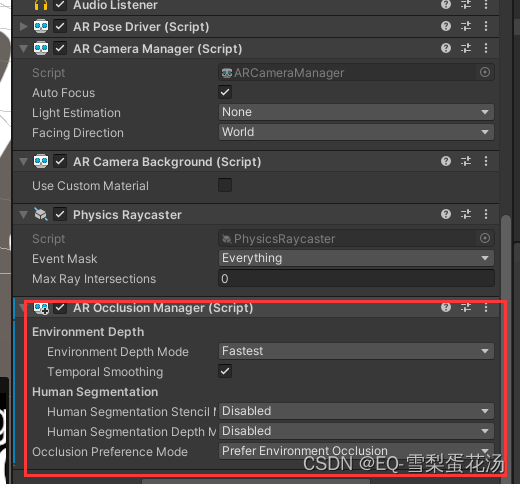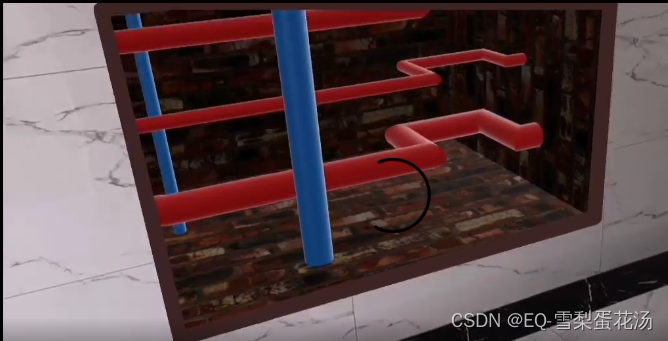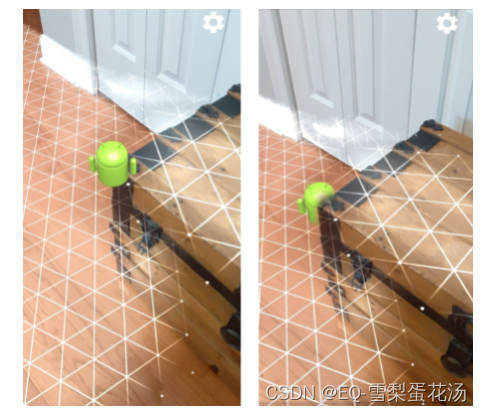遮挡效果
本段描述摘自 https://developers.google.cn/ar/develop/depth
遮挡是深度API的应用之一。
遮挡(即准确渲染虚拟物体在现实物体后面)对于沉浸式 AR 体验至关重要。
参考下图,假设场景中有一个Andy,用户可能需要放置在包含门边有后备箱的场景中。渲染时没有遮挡,Andy 会不切实际地与树干边缘重叠。如果您使用场景的深度来了解虚拟 Andy 相对于木箱等周围环境的距离,就可以准确地渲染 Andy 的遮挡效果,使其在周围环境中看起来更逼真。
图片源自 https://developers.google.cn/ar/develop/depth
使用ARFoundation
ARFoundation中提供了AROcclusionManager脚本,在AR Session Origin的AR Camera对象上挂载该脚本即可。在场景启动后,会自动启用虚实遮挡(当然Depth Mode 不能选择的是disable)。

AROcclusionManager脚本内容如下:
using System;
using System.Collections.Generic;
using Unity.Collections;
using UnityEngine.Serialization;
using UnityEngine.XR.ARSubsystems;
using UnityEngine.Rendering;namespace UnityEngine.XR.ARFoundation
{/// <summary>/// The manager for the occlusion subsystem./// </summary>[DisallowMultipleComponent][DefaultExecutionOrder(ARUpdateOrder.k_OcclusionManager)][HelpURL(HelpUrls.ApiWithNamespace + nameof(AROcclusionManager) + ".html")]public sealed class AROcclusionManager :SubsystemLifecycleManager<XROcclusionSubsystem, XROcclusionSubsystemDescriptor, XROcclusionSubsystem.Provider>{/// <summary>/// The list of occlusion texture infos./// </summary>/// <value>/// The list of occlusion texture infos./// </value>readonly List<ARTextureInfo> m_TextureInfos = new List<ARTextureInfo>();/// <summary>/// The list of occlusion textures./// </summary>/// <value>/// The list of occlusion textures./// </value>readonly List<Texture2D> m_Textures = new List<Texture2D>();/// <summary>/// The list of occlusion texture property IDs./// </summary>/// <value>/// The list of occlusion texture property IDs./// </value>readonly List<int> m_TexturePropertyIds = new List<int>();/// <summary>/// The human stencil texture info./// </summary>/// <value>/// The human stencil texture info./// </value>ARTextureInfo m_HumanStencilTextureInfo;/// <summary>/// The human depth texture info./// </summary>/// <value>/// The human depth texture info./// </value>ARTextureInfo m_HumanDepthTextureInfo;/// <summary>/// The environment depth texture info./// </summary>/// <value>/// The environment depth texture info./// </value>ARTextureInfo m_EnvironmentDepthTextureInfo;/// <summary>/// The environment depth confidence texture info./// </summary>/// <value>/// The environment depth confidence texture info./// </value>ARTextureInfo m_EnvironmentDepthConfidenceTextureInfo;/// <summary>/// An event which fires each time an occlusion camera frame is received./// </summary>public event Action<AROcclusionFrameEventArgs> frameReceived;/// <summary>/// The mode for generating the human segmentation stencil texture./// This method is obsolete./// Use <see cref="requestedHumanStencilMode"/>/// or <see cref="currentHumanStencilMode"/> instead./// </summary>[Obsolete("Use requestedSegmentationStencilMode or currentSegmentationStencilMode instead. (2020-01-14)")]public HumanSegmentationStencilMode humanSegmentationStencilMode{get => m_HumanSegmentationStencilMode;set => requestedHumanStencilMode = value;}/// <summary>/// The requested mode for generating the human segmentation stencil texture./// </summary>public HumanSegmentationStencilMode requestedHumanStencilMode{get => subsystem?.requestedHumanStencilMode ?? m_HumanSegmentationStencilMode;set{m_HumanSegmentationStencilMode = value;if (enabled && descriptor?.humanSegmentationStencilImageSupported == Supported.Supported){subsystem.requestedHumanStencilMode = value;}}}/// <summary>/// Get the current mode in use for generating the human segmentation stencil mode./// </summary>public HumanSegmentationStencilMode currentHumanStencilMode => subsystem?.currentHumanStencilMode ?? HumanSegmentationStencilMode.Disabled;[SerializeField][Tooltip("The mode for generating human segmentation stencil texture.\n\n"+ "Disabled -- No human stencil texture produced.\n"+ "Fastest -- Minimal rendering quality. Minimal frame computation.\n"+ "Medium -- Medium rendering quality. Medium frame computation.\n"+ "Best -- Best rendering quality. Increased frame computation.")]HumanSegmentationStencilMode m_HumanSegmentationStencilMode = HumanSegmentationStencilMode.Disabled;/// <summary>/// The mode for generating the human segmentation depth texture./// This method is obsolete./// Use <see cref="requestedHumanDepthMode"/>/// or <see cref="currentHumanDepthMode"/> instead./// </summary>[Obsolete("Use requestedSegmentationDepthMode or currentSegmentationDepthMode instead. (2020-01-15)")]public HumanSegmentationDepthMode humanSegmentationDepthMode{get => m_HumanSegmentationDepthMode;set => requestedHumanDepthMode = value;}/// <summary>/// Get or set the requested human segmentation depth mode./// </summary>public HumanSegmentationDepthMode requestedHumanDepthMode{get => subsystem?.requestedHumanDepthMode ?? m_HumanSegmentationDepthMode;set{m_HumanSegmentationDepthMode = value;if (enabled && descriptor?.humanSegmentationDepthImageSupported == Supported.Supported){subsystem.requestedHumanDepthMode = value;}}}/// <summary>/// Get the current human segmentation depth mode in use by the subsystem./// </summary>public HumanSegmentationDepthMode currentHumanDepthMode => subsystem?.currentHumanDepthMode ?? HumanSegmentationDepthMode.Disabled;[SerializeField][Tooltip("The mode for generating human segmentation depth texture.\n\n"+ "Disabled -- No human depth texture produced.\n"+ "Fastest -- Minimal rendering quality. Minimal frame computation.\n"+ "Best -- Best rendering quality. Increased frame computation.")]HumanSegmentationDepthMode m_HumanSegmentationDepthMode = HumanSegmentationDepthMode.Disabled;/// <summary>/// Get or set the requested environment depth mode./// </summary>public EnvironmentDepthMode requestedEnvironmentDepthMode{get => subsystem?.requestedEnvironmentDepthMode ?? m_EnvironmentDepthMode;set{m_EnvironmentDepthMode = value;if (enabled && descriptor?.environmentDepthImageSupported == Supported.Supported){subsystem.requestedEnvironmentDepthMode = value;}}}/// <summary>/// Get the current environment depth mode in use by the subsystem./// </summary>public EnvironmentDepthMode currentEnvironmentDepthMode => subsystem?.currentEnvironmentDepthMode ?? EnvironmentDepthMode.Disabled;[SerializeField][Tooltip("The mode for generating the environment depth texture.\n\n"+ "Disabled -- No environment depth texture produced.\n"+ "Fastest -- Minimal rendering quality. Minimal frame computation.\n"+ "Medium -- Medium rendering quality. Medium frame computation.\n"+ "Best -- Best rendering quality. Increased frame computation.")]EnvironmentDepthMode m_EnvironmentDepthMode = EnvironmentDepthMode.Fastest;[SerializeField]bool m_EnvironmentDepthTemporalSmoothing = true;/// <summary>/// Whether temporal smoothing should be applied to the environment depth image. Query for support with/// [environmentDepthTemporalSmoothingSupported](xref:UnityEngine.XR.ARSubsystems.XROcclusionSubsystemDescriptor.environmentDepthTemporalSmoothingSupported)./// </summary>/// <value>When `true`, temporal smoothing is applied to the environment depth image. Otherwise, no temporal smoothing is applied.</value>public bool environmentDepthTemporalSmoothingRequested{get => subsystem?.environmentDepthTemporalSmoothingRequested ?? m_EnvironmentDepthTemporalSmoothing;set{m_EnvironmentDepthTemporalSmoothing = value;if (enabled && descriptor?.environmentDepthTemporalSmoothingSupported == Supported.Supported){subsystem.environmentDepthTemporalSmoothingRequested = value;}}}/// <summary>/// Whether temporal smoothing is applied to the environment depth image. Query for support with/// [environmentDepthTemporalSmoothingSupported](xref:UnityEngine.XR.ARSubsystems.XROcclusionSubsystemDescriptor.environmentDepthTemporalSmoothingSupported)./// </summary>/// <value>Read Only.</value>public bool environmentDepthTemporalSmoothingEnabled => subsystem?.environmentDepthTemporalSmoothingEnabled ?? false;/// <summary>/// Get or set the requested occlusion preference mode./// </summary>public OcclusionPreferenceMode requestedOcclusionPreferenceMode{get => subsystem?.requestedOcclusionPreferenceMode ?? m_OcclusionPreferenceMode;set{m_OcclusionPreferenceMode = value;if (enabled && subsystem != null){subsystem.requestedOcclusionPreferenceMode = value;}}}/// <summary>/// Get the current occlusion preference mode in use by the subsystem./// </summary>public OcclusionPreferenceMode currentOcclusionPreferenceMode => subsystem?.currentOcclusionPreferenceMode ?? OcclusionPreferenceMode.PreferEnvironmentOcclusion;[SerializeField][Tooltip("If both environment texture and human stencil & depth textures are available, this mode specifies which should be used for occlusion.")]OcclusionPreferenceMode m_OcclusionPreferenceMode = OcclusionPreferenceMode.PreferEnvironmentOcclusion;/// <summary>/// The human segmentation stencil texture./// </summary>/// <value>/// The human segmentation stencil texture, if any. Otherwise, <c>null</c>./// </value>public Texture2D humanStencilTexture{get{if (descriptor?.humanSegmentationStencilImageSupported == Supported.Supported &&subsystem.TryGetHumanStencil(out var humanStencilDescriptor)){m_HumanStencilTextureInfo = ARTextureInfo.GetUpdatedTextureInfo(m_HumanStencilTextureInfo,humanStencilDescriptor);DebugAssert.That(((m_HumanStencilTextureInfo.descriptor.dimension == TextureDimension.Tex2D)|| (m_HumanStencilTextureInfo.descriptor.dimension == TextureDimension.None)))?.WithMessage("Human Stencil Texture needs to be a Texture 2D, but instead is "+ $"{m_HumanStencilTextureInfo.descriptor.dimension.ToString()}.");return m_HumanStencilTextureInfo.texture as Texture2D;}return null;}}/// <summary>/// Attempt to get the latest human stencil CPU image. This provides directly access to the raw pixel data./// </summary>/// <remarks>/// The `XRCpuImage` must be disposed to avoid resource leaks./// </remarks>/// <param name="cpuImage">If this method returns `true`, an acquired `XRCpuImage`.</param>/// <returns>Returns `true` if the CPU image was acquired. Returns `false` otherwise.</returns>public bool TryAcquireHumanStencilCpuImage(out XRCpuImage cpuImage){if (descriptor?.humanSegmentationStencilImageSupported == Supported.Supported){return subsystem.TryAcquireHumanStencilCpuImage(out cpuImage);}cpuImage = default;return false;}/// <summary>/// The human segmentation depth texture./// </summary>/// <value>/// The human segmentation depth texture, if any. Otherwise, <c>null</c>./// </value>public Texture2D humanDepthTexture{get{if (descriptor?.humanSegmentationDepthImageSupported == Supported.Supported &&subsystem.TryGetHumanDepth(out var humanDepthDescriptor)){m_HumanDepthTextureInfo = ARTextureInfo.GetUpdatedTextureInfo(m_HumanDepthTextureInfo,humanDepthDescriptor);DebugAssert.That(m_HumanDepthTextureInfo.descriptor.dimension == TextureDimension.Tex2D|| m_HumanDepthTextureInfo.descriptor.dimension == TextureDimension.None)?.WithMessage("Human Depth Texture needs to be a Texture 2D, but instead is "+ $"{m_HumanDepthTextureInfo.descriptor.dimension.ToString()}.");return m_HumanDepthTextureInfo.texture as Texture2D;}return null;}}/// <summary>/// Attempt to get the latest environment depth confidence CPU image. This provides direct access to the/// raw pixel data./// </summary>/// <remarks>/// The `XRCpuImage` must be disposed to avoid resource leaks./// </remarks>/// <param name="cpuImage">If this method returns `true`, an acquired `XRCpuImage`.</param>/// <returns>Returns `true` if the CPU image was acquired. Returns `false` otherwise.</returns>public bool TryAcquireEnvironmentDepthConfidenceCpuImage(out XRCpuImage cpuImage){if (descriptor?.environmentDepthConfidenceImageSupported == Supported.Supported){return subsystem.TryAcquireEnvironmentDepthConfidenceCpuImage(out cpuImage);}cpuImage = default;return false;}/// <summary>/// The environment depth confidence texture./// </summary>/// <value>/// The environment depth confidence texture, if any. Otherwise, <c>null</c>./// </value>public Texture2D environmentDepthConfidenceTexture{get{if (descriptor?.environmentDepthConfidenceImageSupported == Supported.Supported&& subsystem.TryGetEnvironmentDepthConfidence(out var environmentDepthConfidenceDescriptor)){m_EnvironmentDepthConfidenceTextureInfo = ARTextureInfo.GetUpdatedTextureInfo(m_EnvironmentDepthConfidenceTextureInfo,environmentDepthConfidenceDescriptor);DebugAssert.That(m_EnvironmentDepthConfidenceTextureInfo.descriptor.dimension == TextureDimension.Tex2D|| m_EnvironmentDepthConfidenceTextureInfo.descriptor.dimension == TextureDimension.None)?.WithMessage("Environment depth confidence texture needs to be a Texture 2D, but instead is "+ $"{m_EnvironmentDepthConfidenceTextureInfo.descriptor.dimension.ToString()}.");return m_EnvironmentDepthConfidenceTextureInfo.texture as Texture2D;}return null;}}/// <summary>/// Attempt to get the latest human depth CPU image. This provides direct access to the raw pixel data./// </summary>/// <remarks>/// The `XRCpuImage` must be disposed to avoid resource leaks./// </remarks>/// <param name="cpuImage">If this method returns `true`, an acquired `XRCpuImage`.</param>/// <returns>Returns `true` if the CPU image was acquired. Returns `false` otherwise.</returns>public bool TryAcquireHumanDepthCpuImage(out XRCpuImage cpuImage){if (descriptor?.humanSegmentationDepthImageSupported == Supported.Supported){return subsystem.TryAcquireHumanDepthCpuImage(out cpuImage);}cpuImage = default;return false;}/// <summary>/// The environment depth texture./// </summary>/// <value>/// The environment depth texture, if any. Otherwise, <c>null</c>./// </value>public Texture2D environmentDepthTexture{get{if (descriptor?.environmentDepthImageSupported == Supported.Supported&& subsystem.TryGetEnvironmentDepth(out var environmentDepthDescriptor)){m_EnvironmentDepthTextureInfo = ARTextureInfo.GetUpdatedTextureInfo(m_EnvironmentDepthTextureInfo,environmentDepthDescriptor);DebugAssert.That(m_EnvironmentDepthTextureInfo.descriptor.dimension == TextureDimension.Tex2D|| m_EnvironmentDepthTextureInfo.descriptor.dimension == TextureDimension.None)?.WithMessage("Environment depth texture needs to be a Texture 2D, but instead is "+ $"{m_EnvironmentDepthTextureInfo.descriptor.dimension.ToString()}.");return m_EnvironmentDepthTextureInfo.texture as Texture2D;}return null;}}/// <summary>/// Attempt to get the latest environment depth CPU image. This provides direct access to the raw pixel data./// </summary>/// <remarks>/// The `XRCpuImage` must be disposed to avoid resource leaks./// </remarks>/// <param name="cpuImage">If this method returns `true`, an acquired `XRCpuImage`.</param>/// <returns>Returns `true` if the CPU image was acquired. Returns `false` otherwise.</returns>public bool TryAcquireEnvironmentDepthCpuImage(out XRCpuImage cpuImage){if (descriptor?.environmentDepthImageSupported == Supported.Supported){return subsystem.TryAcquireEnvironmentDepthCpuImage(out cpuImage);}cpuImage = default;return false;}/// <summary>/// Attempt to get the latest raw environment depth CPU image. This provides direct access to the raw pixel data./// </summary>/// <remarks>/// > [!NOTE]/// > The `XRCpuImage` must be disposed to avoid resource leaks./// This differs from <see cref="TryAcquireEnvironmentDepthCpuImage"/> in that it always tries to acquire the/// raw environment depth image, whereas <see cref="TryAcquireEnvironmentDepthCpuImage"/> depends on the value/// of <see cref="environmentDepthTemporalSmoothingEnabled"/>./// </remarks>/// <param name="cpuImage">If this method returns `true`, an acquired `XRCpuImage`.</param>/// <returns>Returns `true` if the CPU image was acquired. Returns `false` otherwise.</returns>public bool TryAcquireRawEnvironmentDepthCpuImage(out XRCpuImage cpuImage){if (subsystem == null){cpuImage = default;return false;}return subsystem.TryAcquireRawEnvironmentDepthCpuImage(out cpuImage);}/// <summary>/// Attempt to get the latest smoothed environment depth CPU image. This provides direct access to/// the raw pixel data./// </summary>/// <remarks>/// > [!NOTE]/// > The `XRCpuImage` must be disposed to avoid resource leaks./// This differs from <see cref="TryAcquireEnvironmentDepthCpuImage"/> in that it always tries to acquire the/// smoothed environment depth image, whereas <see cref="TryAcquireEnvironmentDepthCpuImage"/>/// depends on the value of <see cref="environmentDepthTemporalSmoothingEnabled"/>./// </remarks>/// <param name="cpuImage">If this method returns `true`, an acquired `XRCpuImage`.</param>/// <returns>Returns `true` if the CPU image was acquired. Returns `false` otherwise.</returns>public bool TryAcquireSmoothedEnvironmentDepthCpuImage(out XRCpuImage cpuImage){if (subsystem == null){cpuImage = default;return false;}return subsystem.TryAcquireSmoothedEnvironmentDepthCpuImage(out cpuImage);}/// <summary>/// Callback before the subsystem is started (but after it is created)./// </summary>protected override void OnBeforeStart(){requestedHumanStencilMode = m_HumanSegmentationStencilMode;requestedHumanDepthMode = m_HumanSegmentationDepthMode;requestedEnvironmentDepthMode = m_EnvironmentDepthMode;requestedOcclusionPreferenceMode = m_OcclusionPreferenceMode;environmentDepthTemporalSmoothingRequested = m_EnvironmentDepthTemporalSmoothing;ResetTextureInfos();}/// <summary>/// Callback when the manager is being disabled./// </summary>protected override void OnDisable(){base.OnDisable();ResetTextureInfos();InvokeFrameReceived();}/// <summary>/// Callback as the manager is being updated./// </summary>public void Update(){if (subsystem != null){UpdateTexturesInfos();InvokeFrameReceived();requestedEnvironmentDepthMode = m_EnvironmentDepthMode;requestedHumanDepthMode = m_HumanSegmentationDepthMode;requestedHumanStencilMode = m_HumanSegmentationStencilMode;requestedOcclusionPreferenceMode = m_OcclusionPreferenceMode;environmentDepthTemporalSmoothingRequested = m_EnvironmentDepthTemporalSmoothing;}}void ResetTextureInfos(){m_HumanStencilTextureInfo.Reset();m_HumanDepthTextureInfo.Reset();m_EnvironmentDepthTextureInfo.Reset();m_EnvironmentDepthConfidenceTextureInfo.Reset();}/// <summary>/// Pull the texture descriptors from the occlusion subsystem, and update the texture information maintained by/// this component./// </summary>void UpdateTexturesInfos(){var textureDescriptors = subsystem.GetTextureDescriptors(Allocator.Temp);try{int numUpdated = Math.Min(m_TextureInfos.Count, textureDescriptors.Length);// Update the existing textures that are in common between the two arrays.for (int i = 0; i < numUpdated; ++i){m_TextureInfos[i] = ARTextureInfo.GetUpdatedTextureInfo(m_TextureInfos[i], textureDescriptors[i]);}// If there are fewer textures in the current frame than we had previously, destroy any remaining unneeded// textures.if (numUpdated < m_TextureInfos.Count){for (int i = numUpdated; i < m_TextureInfos.Count; ++i){m_TextureInfos[i].Reset();}m_TextureInfos.RemoveRange(numUpdated, (m_TextureInfos.Count - numUpdated));}// Else, if there are more textures in the current frame than we have previously, add new textures for any// additional descriptors.else if (textureDescriptors.Length > m_TextureInfos.Count){for (int i = numUpdated; i < textureDescriptors.Length; ++i){m_TextureInfos.Add(new ARTextureInfo(textureDescriptors[i]));}}}finally{if (textureDescriptors.IsCreated){textureDescriptors.Dispose();}}}/// <summary>/// Invoke the occlusion frame received event with the updated textures and texture property IDs./// </summary>void InvokeFrameReceived(){if (frameReceived != null){int numTextureInfos = m_TextureInfos.Count;m_Textures.Clear();m_TexturePropertyIds.Clear();m_Textures.Capacity = numTextureInfos;m_TexturePropertyIds.Capacity = numTextureInfos;for (int i = 0; i < numTextureInfos; ++i){DebugAssert.That(m_TextureInfos[i].descriptor.dimension == TextureDimension.Tex2D)?.WithMessage($"Texture needs to be a Texture 2D, but instead is {m_TextureInfos[i].descriptor.dimension.ToString()}.");m_Textures.Add((Texture2D)m_TextureInfos[i].texture);m_TexturePropertyIds.Add(m_TextureInfos[i].descriptor.propertyNameId);}subsystem.GetMaterialKeywords(out List<string> enabledMaterialKeywords, out List<string>disabledMaterialKeywords);AROcclusionFrameEventArgs args = new AROcclusionFrameEventArgs();args.textures = m_Textures;args.propertyNameIds = m_TexturePropertyIds;args.enabledMaterialKeywords = enabledMaterialKeywords;args.disabledMaterialKeywords = disabledMaterialKeywords;frameReceived(args);}}}
}使用EQ-R实现
EQ-R
简介
EQ-Renderer是EQ基于sceneform(filament)扩展的一个用于安卓端的三维AR渲染器。
主要功能
它包含sceneform_v1.16.0中九成接口(剔除了如sfb资源加载等已弃用的内容),扩展了视频背景视图、解决了sceneform模型加载的内存泄漏问题、集成了AREngine和ORB-SLAM3、添加了场景坐标与地理坐标系(CGCS-2000)的转换方法。
注:由于精力有限,文档和示例都不完善。sceneform相关请直接参考谷歌官方文档,扩展部分接口说明请移步git联系。
相关链接
Git仓库
- EQ-Renderer的示例工程
码云
- EQ-Renderer的示例工程
EQ-R相关文档
- 文档目录
使用示例
需要在安卓清单中添加其值设为“com.google.ar.core.depth>
接口调用
在使用ARSceneLayout 创建AR布局控件时,在适当的地方修改深度遮挡模式即可,示例如下。
ARSceneLayout layout = new ARSceneLayout(this);//使用普通3d视图
layout.getSceneView.getCameraStream()setDepthOcclusionMode(DepthOcclusionMode.DEPTH_OCCLUSION_ENABLED);
实现方式
获取深度图和相机帧,在着色器中根据深度数据处理。
EQ-R基于filament
filament材质如下:
material {name : depth,shadingModel : unlit,blending : opaque,vertexDomain : device,parameters : [{type : samplerExternal,name : cameraTexture},{type : sampler2d,name : depthTexture},{type : float4x4,name : uvTransform}],requires : [uv0]
}fragment {void material(inout MaterialInputs material) {prepareMaterial(material);material.baseColor.rgb = inverseTonemapSRGB(texture(materialParams_cameraTexture, getUV0()).rgb);vec2 packed_depth = texture(materialParams_depthTexture, getUV0()).xy;float depth_mm = dot(packed_depth, vec2(255.f, 256.f * 255.f));vec4 view = mulMat4x4Float3(getClipFromViewMatrix(), vec3(0.f, 0.f, -depth_mm / 1000.f));float ndc_depth = view.z / view.w;gl_FragDepth = 1.f - ((ndc_depth + 1.f) / 2.f);}
}vertex {void materialVertex(inout MaterialVertexInputs material) {material.uv0 = mulMat4x4Float3(materialParams.uvTransform, vec3(material.uv0.x, material.uv0.y, 0.f)).xy;}
} 示例应用
之前基于Android(Java)做过的示例应用。
管线巡检示例 :开挖显示、卷帘效果…





数据结构——正则表达式)


)

:入门篇,Docker概述、基本组成等,对Docker有一个初步的认识)







--装饰器/生成器/夹具的使用/描述符的作用/ddt驱动/多线程)


